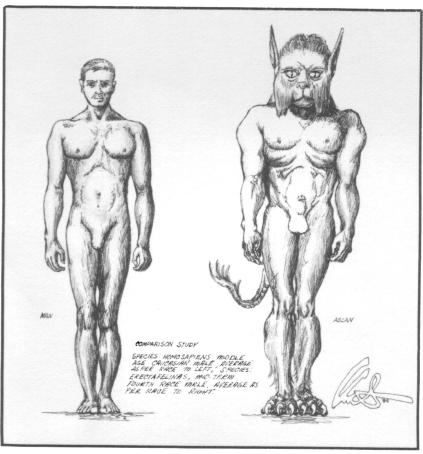Aslan

- -2 Dexterity, +1 Constitution, +1 Strength
- Medium: As Medium creatures, Aslan have no special bonuses
or penalties due to their size.
- Aslan base land speed is 30 feet.
- Low-Light
Vision: An elf can see twice as far as a human in starlight,
moonlight,
torchlight, and similar conditions of poor illumination. She
retains
the ability to distinguish color and detail under these
conditions.
- +1 to Hearing attribute
- +2 racial bonus on Listen, Search,
and Spot
checks. All Aslan have a +1 to Tooth and Claw Fighting skill.
Only
Aslan can
get this skill.
- Favored Class:
The Aslan are a race of intelligent beings; there some archeological
evidance that this is the youngest of all the major races.. Driven
by
the instinctive territorial desires which are central to the makeup
of
the Aslan male, they have overcome most of the predijuce that once
plagued them.
The Aslan characters starts out with:
Tooth and Claw Feat:
This feat gives them the ability to use a non-grapple unarmed attack
that counts as an "armed" attack in that it does not provoke an
attack
of opportunity. They get 2 attacks at 1d3+1 damage and their normal
BAB. Optionally, the character may choose to bite for 1d3+1 points
of
damage as a 3rd attack, but this DOES provoke an attack of
opportunity
from and armed or unarmed opponent.
Sprint Skill: When running, the character moves a maximum of
five
times his or her normal speed instead of four times. If the
character
is in heavy armor, the character can move four times his or her
speed
rather than three times. If the character makes a long jump, the
character gains a +2 competence bonus on his or her Jump check.
Fatigue
rolls will begin atn 1/2 the characters constitution score in
rounds.
ASLAN PHYSIOLOGY
Aslan are descended from four-limbed carnivorous pouncer stock.
Early
on in their development they began hunting in prides of several
families. The strongest male became the leader, and his family
received
the best parts of kills, choice sleeping places, and first drink
at any
waterhole.
The Aslan which has evolved from those beginnings is an upright
biped averaging 2 meters in height and 100 kg (220 lbs) in weight.
There are two sexes: male and female, of which the most notable
external difference is the male's increased size and more
impressive
mane. Females outnumber males by a ratio of 3:1.
The Aslan hand has three fingers opposing one medially-placed
thumb,
and all have retractable claws. In addition, Aslan have a single
highly
specialized claw under each thumb; this dewclaw folds back
jack-knife
fashion into a horny covering in the base of the thumb and palm.
The
presence of these claws and the general nature of their body
structure
make the Aslan somewhat clumsy by comparison with humans, but what
they
lack in dexterity they make up for in strength and endurance.
True to their pouncer ancestry, Aslan are capable of short bursts of
speed somewhat greater than that manageable by humans. They also
have
slightly superior hearing and night vision. Otherwise, they are one
of
the most human-like of all alien races, excepting, of course, the
Vargr
(who are, after all, genetically-altered mammalian stock originally
from Earth).
The Aslan actually bear little resemblance to Terrestrial lions.
Nonetheless, this early misnomer has influenced a great deal of
human
thinking about the Aslan, including terminology (the use of pride
to
translate ahriy, for instance) and ascribed behavior—which is not
at
all leonine.
The Aslan have long been a warrior race; they are noble and proud,
devoted to those in authority above them and responsible for those
who
owe fealty from below. Aslan society is based on the family and its
relationships.
Family Structures: An individual Aslan is usually a member of a
family
(ekho) of from 2 to 12 persons under a patriarchal leader.
This family will generally include the male family head, one or more
wives, plus children and various blood relatives of the leader
(unmarried brothers and sisters, aged surviving parents no longer
maintaining separate families, adopted orphans of blood relatives).
Several families combine into a pride (ahriy), with one family
dominant.
The leader of that family is also the leader of the pride. Other
families owe him and his family their fealty. A number of prides
form a
clan (huiha), with one pride dominant. Again, prides in the clan owe
fealty to the clan's leader. The clan's leader is expected, in turn,
to
protect and provide for members of the clan, settling disputes
between
prides within the clan, and administering his holdings wisely and
well.
Clans may, in turn, owe fealty to more powerful clans, particularly
where blood relationships exist.
